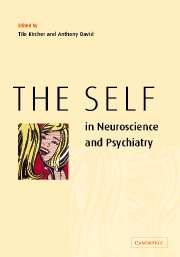Book contents
- Frontmatter
- Contents
- List of contributors
- Introduction: the self and neuroscience
- Part I Conceptual background
- Part II Cognitive and neurosciences
- 5 The multiplicity of consciousness and the emergence of the self
- 6 Asynchrony, implicational meaning and the experience of self in schizophrenia
- 7 Self-awareness, social intelligence and schizophrenia
- 8 The neural correlates of self-awareness and self-recognition
- 9 Autonoetic consciousness
- 10 The neural nature of the core SELF: implications for understanding schizophrenia
- Part III Disturbances of the self: the case of schizophrenia
- 11 Self and schizophrenia: a phenomenological perspective
- 12 Self-disturbance in schizophrenia: hyperreflexivity and diminished self-affection
- 13 The self-experience of schizophrenics
- 14 The paranoid self
- 15 Schizophrenia and the narrative self
- 16 Self-narrative in schizophrenia
- 17 Schizophrenia as disturbance of the self-construct
- 18 Action recognition in normal and schizophrenic subjects
- 19 Disorders of self-monitoring and the symptoms of schizophrenia
- 20 Hearing voices or hearing the self in disguise? Revealing the neural correlates of auditory hallucinations in schizophrenia
- 21 The cognitive neuroscience of agency in schizophrenia
- 22 Self-consciousness: an integrative approach from philosophy, psychopathology and the neurosciences
- References
22 - Self-consciousness: an integrative approach from philosophy, psychopathology and the neurosciences
from Part III - Disturbances of the self: the case of schizophrenia
Published online by Cambridge University Press: 18 December 2009
- Frontmatter
- Contents
- List of contributors
- Introduction: the self and neuroscience
- Part I Conceptual background
- Part II Cognitive and neurosciences
- 5 The multiplicity of consciousness and the emergence of the self
- 6 Asynchrony, implicational meaning and the experience of self in schizophrenia
- 7 Self-awareness, social intelligence and schizophrenia
- 8 The neural correlates of self-awareness and self-recognition
- 9 Autonoetic consciousness
- 10 The neural nature of the core SELF: implications for understanding schizophrenia
- Part III Disturbances of the self: the case of schizophrenia
- 11 Self and schizophrenia: a phenomenological perspective
- 12 Self-disturbance in schizophrenia: hyperreflexivity and diminished self-affection
- 13 The self-experience of schizophrenics
- 14 The paranoid self
- 15 Schizophrenia and the narrative self
- 16 Self-narrative in schizophrenia
- 17 Schizophrenia as disturbance of the self-construct
- 18 Action recognition in normal and schizophrenic subjects
- 19 Disorders of self-monitoring and the symptoms of schizophrenia
- 20 Hearing voices or hearing the self in disguise? Revealing the neural correlates of auditory hallucinations in schizophrenia
- 21 The cognitive neuroscience of agency in schizophrenia
- 22 Self-consciousness: an integrative approach from philosophy, psychopathology and the neurosciences
- References
Summary
Abstract
In this chapter, we want to try and integrate the divergent lines introduced in the other parts of this book. We propose a model of self-consciousness derived from phenomenology, philosophy, the cognitive and neurosciences. We will then give an overview of research data on self-processing from various fields and link it to our model. Some aspects of the disturbances of the self in pathological states such as brain lesions and schizophrenia will be discussed. Finally, the clinically important concept of insight into a disease and its neurocognitive origin will be introduced. We argue that self-consciousness is a valid construct and, as shown in this chapter, it is possible that it can be studied with the instruments of cognitive neuroscience.
Introduction
The self as an entity distinct from the other has entered western thought through Greek philosophy (see chapter 1, this volume, for details). Throughout history, a myriad of different notions, starting from theology, philosophy, psychoanalysis, to early psychological concepts, psychopathology, the social sciences, and, more recently, cognitive psychology, neurology and the neurosciences have been developed. With the advent of scientific interest in consciousness towards the end of the twentieth century, self-consciousness has also become a topic taken up by the neuroscientific community. As a first phenomenological approximation based on commonly shared experience, we know that we are the same person across time, that we are the author of our thoughts/actions, and that we are distinct from the environment.
- Type
- Chapter
- Information
- The Self in Neuroscience and Psychiatry , pp. 445 - 474Publisher: Cambridge University PressPrint publication year: 2003
References
- 17
- Cited by



